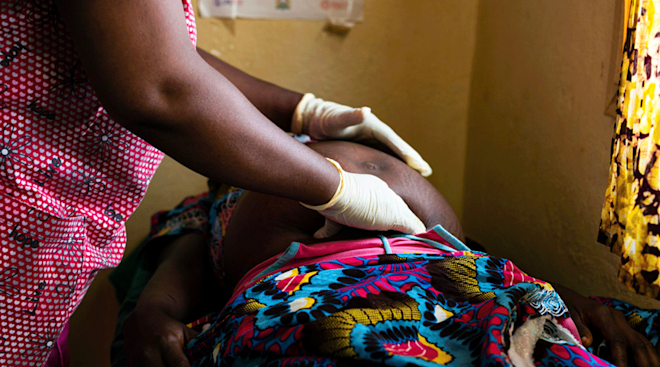Placenta Accreta: What It Means for Mom and Baby
If you’ve been diagnosed with placenta accreta spectrum or have been told you have risk factors, some frantic Googling has probably taken place—and what you’ve found might be pretty unsettling.
First and foremost, take a deep breath. While it’s true that placenta accreta is a very serious pregnancy complication, planning ahead and receiving proactive care can help improve the outcome for you and baby.
If you have placenta accreta, you and your doctor will want to have a plan of action. That starts with information and education. To that end, we’re sharing everything you need to know about this condition. So what is placenta accreta, are there risk factors or symptoms to look for and what is the general prognosis? Read on to get the facts.
Placenta accreta, now commonly called placenta accreta spectrum, is a rare but dangerous condition that happens when the placenta attaches too deeply to the wall of the uterus during pregnancy.
“It’s a serious complication that can occur in women, especially those who have specific risk factors,” says James Hill, MD, maternal-fetal medicine division director at the Center for Maternal and Fetal Care at The Children’s Hospital of San Antonio.
During a normal birth, the placenta separates from the wall of the uterus and is delivered after the baby. But with placenta accreta, the placenta doesn’t fully detach, and this can cause a woman to experience significant and potentially life-threatening bleeding.
How common is placenta accreta?
The comforting news is that placenta accreta is not very common; however, the numbers are rather mixed. According to the American College of Obstetricians and Gynecologists (ACOG), some research shows that placenta accreta spectrum affects roughly 1 in 530 women, while other studies have found the number may be closer to 1 in 272 women.
In either case, the percentage is higher than it was in past decades. “If you go back 30 or 40 years ago, the incidence was something like 1 in 2,500,” Hill explains. The jump, ACOG notes, may be the result of increased c-section rates. C-sections can cause uterine scarring, which significantly raises the risk of placenta accreta.
Doctors officially use the term “placenta accreta spectrum” when talking about the condition because it can take a few different forms with varying degrees of severity.
Depending on how deeply the placenta is attached to the uterine wall, placenta accreta spectrum can be diagnosed as placenta accreta, placenta increta or placenta percreta, explains Kecia Gaither, MD, director of perinatal services at NYC Health + Hospitals/Lincoln.
Placenta accreta vs. percreta
Placenta accreta happens when a woman’s placenta remains attached to the outermost layer of the uterine wall, next to the muscular layer of the uterus. “The placenta sort of adheres to the superficial surface. It’s more common, occurring in about 65 percent of placenta accreta spectrum cases,” Hill says.
In cases of placenta percreta, the placenta attaches to the uterine wall and continues to grow through it. “The placenta can attach to adjacent pelvic organs like the bladder,” Gaither explains. This deeper attachment is more serious than placenta accreta, but it’s significantly less common. “It accounts for around 20 percent of placenta accreta spectrum cases,” Hill notes.
Placenta accreta vs. increta
Placenta increta, on the other hand, happens when the placenta grows into the muscles of the uterus. Like placenta percreta, the attachment is deeper and more serious than placenta accreta and poses a higher risk for significant or life-threatening bleeding. “It’s less common than placenta increta or placenta percreta,” says Hill.
Placenta accreta spectrum can cause complications for Mom and baby. The biggest risk for women is severe bleeding, which happens when part or all of the placenta stays attached to the uterine wall after delivery. In some cases the bleeding may be life-threatening, create the need for a blood transfusion and potentially even call for a hysterectomy.
Placenta accreta spectrum usually means a preterm birth for baby. If you are diagnosed with placenta accreta during pregnancy, your ob-gyn will most likely plan for an early c-section to help reduce the risk of hemorrhaging during delivery.
There’s no denying that this is serious. The possibility of severe blood loss is worrisome, and placenta accreta can be fatal. But when properly managed, the placenta accreta survival rate is high: between 96 and 99 percent, according to a recent review published in Clinical Obstetrics & Gynecology. It’s about planning for care with the diagnosis, using a multidisciplinary team, and making sure you’re delivering at a facility that’s prepared, Hill says.
Placenta accreta spectrum happens when an abnormality within the lining of the uterus causes the placenta to attach itself and become stuck. The most accepted theory is that it’s caused by previous trauma or scarring to the uterine lining, Hill explains. Often, that comes from a previous c-section or procedures like dilation & curettage (D&C) or myomectomy, which is often performed to remove uterine fibroids.
Placenta accreta risk factors
While it’s possible for any woman to develop placenta accreta spectrum, the condition usually affects moms-to-be with certain risk factors. These include:
• Previous c-sections. Cesarean deliveries can cause scarring to the uterine lining, increasing the chances for placenta accreta spectrum if a woman becomes pregnant again. Anybody who’s had a previous c-section delivery should be watched closely by their provider, says Hill. Typically, the more c-sections you have had, the greater the risk.
• History of uterine procedures. If you’ve previously had a uterine procedure, such as D&C or fibroid removal, you may have scars on the uterine lining that up the risk for placenta accreta spectrum.
• Placenta previa diagnosis. Placenta previa happens when the placenta sits lower in the uterus than it should, increasing the risk for severe vaginal bleeding during pregnancy or delivery. Women who are diagnosed with placenta previa will be closely watched for placenta accreta spectrum.
• Being over 35. Like with most other pregnancy complications, the risk for placenta accreta spectrum generally increases with age.
• Being pregnant with multiples. Twin, triplet or other multiple pregnancies also pose a higher risk for complications in general.
Knowing your risk factors can help a you and your care team diagnose placenta accreta spectrum earlier. This is key, since being aware of the condition before giving birth allows your doctors to prepare for a safe delivery.
The most common sign of placenta accreta is vaginal bleeding. “The bleeding could come from the uterus or bladder or from the rectum, depending if the placental tissue has invaded these structures,” Gaither explains. Some women also experience abdominal pain.
Keep in mind, though, that not every woman who has vaginal bleeding or pain has placenta accreta spectrum. It’s also possible to have no symptoms with placenta accreta. This makes it even more crucial to discuss any risk factors with your doctor to decide whether you should be monitored for the condition.
Getting diagnosed with placenta accreta spectrum earlier in pregnancy gives Mom and baby the best chance for a safe birth. Usually, the condition is spotted on an ultrasound. “You can pick it up in the first trimester, but typically you see it in the second or third trimester,” Hill says.
If you have placenta accreta spectrum risk factors, your provider will look at your first and second trimester ultrasounds closely to check for signs of possible placental attachment. If placenta accreta spectrum is suspected, an MRI can help your care team learn more about the diagnosis—including where and how deeply the placenta is attached, Gaither says.
Placenta accreta spectrum puts a pregnancy in the high-risk category, so it’s critical to work with a maternal-fetal medicine specialist and give birth at a hospital equipped to handle the condition, the ACOG recommends.
During the remainder of your pregnancy, your doctor might encourage pelvic rest (aka, no sex), and even bed rest. These recommendations are usually individualized based on the severity of your placenta accreta.
Your care team will also work with you to develop a delivery plan that reduces the risk for severe blood loss. This typically means giving birth early (often between 34 and 35 weeks, but as late as 38 weeks) via c-section. “Placenta accreta spectrum is more difficult to manage when a woman goes into delivery naturally,” Hill says.
If a woman’s placenta is deeply attached to the uterine lining, she might need to undergo a hysterectomy at the time of her c-section. “It depends on how invasive the placenta accreta spectrum is,” Hill explains. “Removing the uterus results in less bleeding than just trying to remove the placenta.”
Planning for an early birth via c-section and potentially having a hysterectomy can greatly reduce the chances for serious or life-threatening bleeding. That said, you might need a blood transfusion or may be placed in intensive care in order to recover. Though it’s hard to feel completely at peace with these possibilities, having open and honest conversations with your doctor and medical team can help you understand your individual risk factors and give you the opportunity to voice your concerns.
Placenta accreta spectrum is a serious complication, and it can be scary to think about. Educating yourself and working with your doctor to have a plan in place can help make this scary scenario a little easier—and give you and baby the best chance at a healthy, happy start.
About the experts:
Kecia Gaither, MD, MPH, FACOG, is an ob-gyn, maternal-fetal medicine specialist and director of perinatal services at NYC Health + Hospitals/Lincoln. She received her medical degree from SUNY Health Science Center in Syracuse, New York.
James Hill, MD, serves as maternal-fetal medicine division director at the Center for Maternal and Fetal Care at The Children’s Hospital of San Antonio. He received his medical degree at the University of Florida College of Medicine in Gainesville, Florida.
Please note: The Bump and the materials and information it contains are not intended to, and do not constitute, medical or other health advice or diagnosis and should not be used as such. You should always consult with a qualified physician or health professional about your specific circumstances.
Plus, more from The Bump:
Navigate forward to interact with the calendar and select a date. Press the question mark key to get the keyboard shortcuts for changing dates.




















































